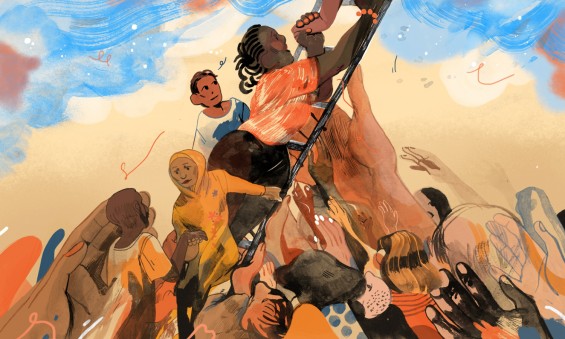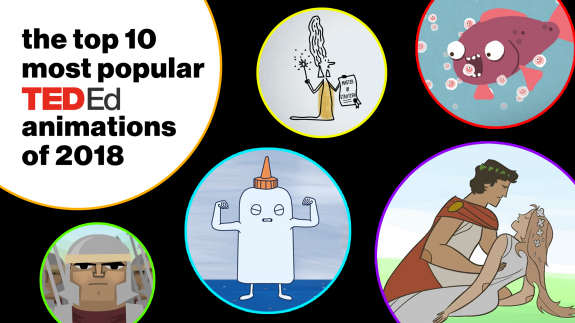
The 10 most popular TED-Ed Animations of 2018

In 2018, our YouTube audience spent over 20 million hours watching TED-Ed Animations. Our most-viewed videos of 2018 include a handful of monumental myths, an epic battle of tape vs. glue, a menagerie of the animal kingdom’s most competitive cannibals, and more. Behold our top 10 most popular videos of 2018:
1. Can you solve the wizard standoff riddle?
You’ve been chosen as a champion to represent your wizarding house in a deadly duel against two rival magic schools. Your opponents are a powerful sorcerer who wields a wand that can turn people into fish, and a powerful enchantress who wields a wand that turns people into statues. Can you choose a wand and devise a strategy that ensures you will win the duel? Dan Finkel shows how. Watch this TED-Ed Animation below.
2. A day in the life of a Roman soldier
The year is 15 CE, and the Roman Empire is prospering. Most of the credit will go to the emperor, but this success wouldn’t have been possible without loyal soldiers like Servius Felix. Robert Garland illuminates what life was like for a solider in the Roman army. Watch this TED-Ed Animation below.
3. Which is stronger: Glue or tape?
The oldest glue in the world is over 8,000 years old and comes from a cave near the Dead Sea. Today, we have enough types of tape and glue to build and repair almost anything. But what gives glue and tape their stickiness? And is one stronger than the other? Elizabeth Cox explores the world of adhesives. Watch this TED-Ed Animation below.
4. The myth of Arachne
From sailors who were turned into pigs, nymphs that sprouted into trees, and a gaze that converted the beholder to stone, Greek mythology brims with shape-shifters. The powerful Gods usually changed their own forms at will – but for mortals, the mutations were often unwanted. Iseult Gillespie shares how one such unnerving transformation befell the spinner Arachne. Watch this TED-Ed Animation below.
5. The myth of Thor’s journey to the land of giants
Thor—son of Odin, god of thunder, and protector of mankind—struggled mightily against his greatest challenge yet: opening a bag of food. How had the mighty god fallen so far? Scott Mellor tells the myth of Thor’s journey to Utgard. Watch this TED-Ed Animation below.
6. The tragic myth of Orpheus and Eurydice
The marriage of Orpheus, the greatest of all poets and musicians, to Eurydice, a wood nymph, was heralded as the perfect union. Anyone could tell the couple was deeply in love. So when their wedding ceremony ended in Eurydice’s untimely death, Orpheus had no choice but to venture into the underworld to try to reclaim his lost love. Brendan Pelsue shares the tragic myth of Orpheus and Eurydice. Watch this TED-Ed Animation below.
7. Why can’t you divide by zero?
In the world of math, many strange results are possible when we change the rules. But there’s one rule that most of us have been warned not to break: don’t divide by zero. How can the simple combination of an everyday number and a basic operation cause such problems? Watch this TED-Ed Animation below.
8. The myth of King Midas and his golden touch
In Greek mythology, King Midas is known as a rogue ruler whose antics bemused his people and irritated the Gods. Many know the classic story of Midas’s golden touch, but the foolish king was also known for his unusual pair of ears. Iseult Gillespie shares the myth of King Midas. Watch this TED-Ed Animation below.
9. Cannibalism in the animal kingdom
Until recently, scientists thought cannibalism was a rare response to starvation or other extreme stress. Well-known cannibals like the praying mantis and black widow were considered bizarre exceptions. But now, we know they more or less represent the rule. Bill Schutt shows how cannibalism can promote the survival of a species by reducing competition, culling the weak, and bolstering the strong. Watch this TED-Ed Animation below.
10. Can you solve the seven planets riddle?
Your interstellar police squad has tracked a group of criminals to a cluster of seven planets. Now you must apprehend them before their reinforcements arrive. Of course, the fugitives won’t just stay put – they’ll try to dodge you by moving from planet to planet. Can you devise a sequence for searching the planets that’s guaranteed to catch them in ten warps or less? Edwin F. Meyer shows how. Watch this TED-Ed Animation below.
On behalf of everyone here at TED-Ed, thanks for learning with us this year!
To get brand new TED-Ed Animations delivered to your inbox for free in 2019, sign up for the TED-Ed weekly newsletter here >>



